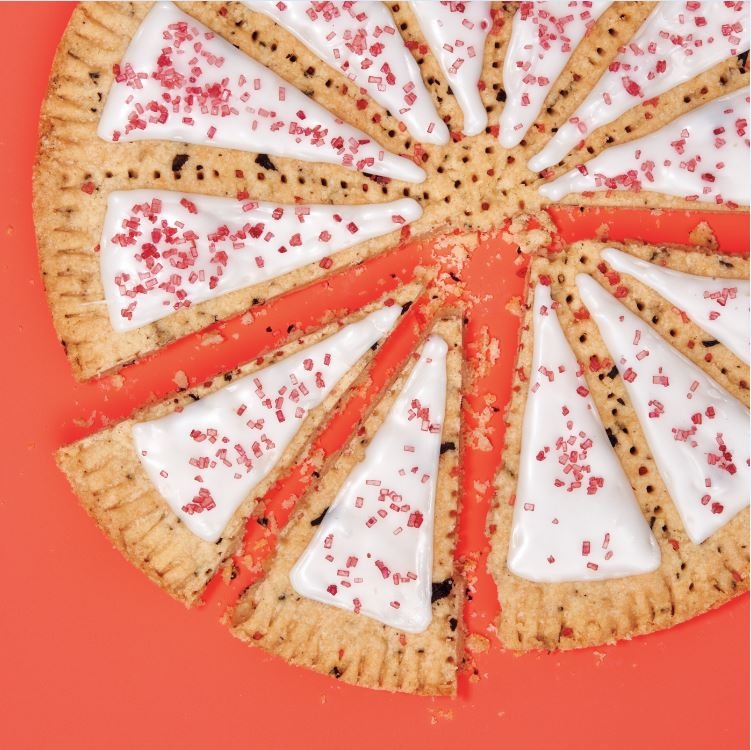Rose-Hibiscus Shortbread Fans
Rose-Hibiscus Shortbread Fans
Thanks to my friendship with Pierre Hermé, the fabulous French pastry chef, I fell in love with the flavor of rose in pastry. It was Pierre who began using rose in his desserts about twenty years ago, and now you find it everywhere in France and in everything from granola and yogurt to the fanciest cakes. It’s a haunting flavor and one that blends beautifully with red berries and another red flower, hibiscus. There’s just one caveat: A flavor as strong and aromatic as rose (particularly when it’s an extract) must whisper — never proclaim — its presence. Too much rose is really too much. Actually, too much hibiscus is not a good thing either. Go easy on both flavorings, though, and you’ll have an elegant cookie.The key to the delightfully crumbly texture, the kind you get with Scottish shortbread, is rice flour, which has little gluten and no distinguishable flavor; it’s there just for the sandiness it imparts.I like to press the dough into a round cake pan, then cut the baked cookies into wedges, ice them and sprinkle each shortbread fan with a few grains of rose-colored sanding sugar. It’s a girly look, but it’s so pretty and particularly welcome on a chilly day when you’re yearning for spring.A word on special ingredients: My favorite rose extract is made by Star Kay White. If you can’t find it, you can substitute an equal amount of rose water (Nielsen-Massey sells a lovely one). If you can’t find a pure hibiscus tea (I use one from the Wild Hibiscus Flower Co.), you can use Celestial Seasonings Red Zinger. Finally, the rice flour should be white rice flour, not sweet or sticky rice flour; Bob’s Red Mill sells it. If you’d prefer a recipe that uses only all-purpose flour, see Playing Around.Recipe excerpted from Dorie Greenspan’s newest cookbook Dorie’s Cookies. Click here to purchase your own copy.
Servings
6

Ingredients
- 3/4 cup (102 grams) all-purpose flour
- 1/2 cup (85 grams) white rice flour
- 1/3 cup (67 grams) sugar
- 2 teaspoon hibiscus tea leaves
- 1 stick (8 tablespoons; 4 ounces; 113 grams) unsalted butter, cut into chunks, at room temperature
- 1/4 teaspoon fine sea salt
- 1/2 teaspoon pure vanilla extract
- 1/4 teaspoon pure rose extract
- 1/2 cup (60 grams) confectioners’ sugar, sifted
- 1 to 2 tablespoon milk
- rose-colored sanding sugar, for dusting
Directions
- Center a rack in the oven and preheat it to 350 degrees F. Butter an 8-inch round cake pan, dust with flour and tap out the excess.
- Whisk both flours together.
- Toss the sugar and tea into a stand mixer, or into a large bowl in which you can use a hand mixer. Rub the ingredients together with your fingertips until fragrant. If using a stand mixer, fit it with the paddle attachment. Add the butter and salt to the bowl and beat on medium speed until the mixture is smooth, about 2 minutes. Beat in the vanilla and rose extracts. Turn off the mixer, add the flour all at once and mix on low speed. After 3 to 4 minutes, you’ll have a bowl of soft, moist curds and crumbs. Squeeze a few curds, and if they hold together, you’re good to go. (You don’t want to mix the dough until it comes together uniformly.)
- Turn the crumbs into the pan and pat them down evenly. If you’d like to smooth the top, “roll” the crumbs using a spice bottle as a rolling pin. (You can also tap down the crumbs with the bottom of a small measuring cup.) Be firm but not forceful; the point is to knit the crumbs together and just lightly compress them. Using the tines of a dinner fork and pressing down so that you hear the metal tap against the pan, prick lines of holes in the dough to create a dozen wedges. Finish by pressing the bottom of the tines horizontally around the edges of the dough, as though you were crimping a piecrust.
- Bake the shortbread for 25 to 27 minutes, rotating the pan after 15 minutes, or until the top feels firm to the touch and the edges have a tinge of color; the center should remain fairly pale. Transfer the pan to a rack and allow to rest for 5 minutes. Prick the holes you made again, then carefully run a table knife between the pan and the shortbread and even more carefully turn the shortbread over onto the rack. Then invert it onto a cutting board and use a long sturdy knife or a bench scraper to cut the shortbread along the pricked lines. Lift the pieces back onto the rack and allow the fans to cool before icing or serving.
- Put the confectioners’ sugar in a small bowl, add 1 tablespoon milk and stir to blend. If the icing is too thick to brush or spread smoothly and easily, add more milk drop by drop. Using a pastry brush or a small icing spatula, ice each shortbread wedge. You can ice the whole wedge or leave a thin border, my preference. Or just swipe one long side of each fan with icing. Sprinkle a few grains of sanding sugar on each fan and let the icing set.
- Storing: The shortbread will keep for at least 1 week in a tightly covered container at room temperature. If you omit the icing, you can freeze the shortbread for up to 2 months.
- Playing Around: For All-Purpose Shortbread, omit the rice flour and use 1 cup plus 2 tablespoons all-purpose flour.